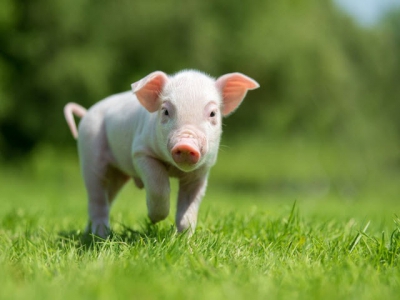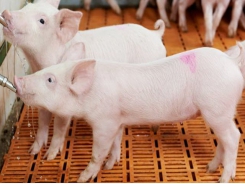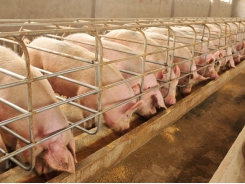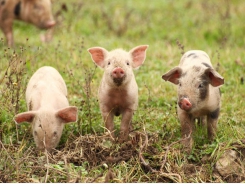How can the prenatal phase influence the lifelong performance of a pig?

Trouw Nutrition is expanding its original swine LifeStart concept, looking at how conditions during the prenatal phase can influence the lifelong performance of a pig.
Pig breeders and farmers have long sought to increase litter size, but productivity enhancements are resulting in challenges such as perinatal and neonatal losses, a higher number of low-birth-weight piglets and reduced availability of sow milk.
Trouw Nutrition is aiming, in particular, to help manage sow peripartal syndrome - a breadth of interrelated challenges experienced by mother sows and piglets throughout the peripartal period, which was first described by Dr An Cools in 2013.
Researchers have identified three sets of challenges associated with that syndrome:
- A first set of challenges originates before the peripartal period - for example, suboptimal body condition, mummification, low birth weight.
- The second set of challenges originates during the peripartal period - for example, low colostrum production (hypogalactia), stillbirth.
- A third set of challenges only becomes observable after the peripartal period - for example, low milk production (hypogalactia), low vitality, and neonatal mortality.
A comprehensive strategy is needed that supports sows and piglets during the in-utero, pre-weaning and post-weaning phase so as to address sow peripartal syndrome and optimize a piglet’s lifetime performance, said Dr Ruben Decaluwe, technical manager swine, at Trouw Nutrition.
The LifeStart swine team is hoping to unravel the pathways contributing to that syndrome, and is focusing on four parameters observable in piglets following parturition, including:
- Being born alive
- Adequate birth weight
- Adequate colostrum intake
- Adequate vitality
Influence of the sow
We caught up with Dr Decaluwe to hear more about this line of research.
“In 2015, we originally conceived of the LifeStart program at beginning at the birth of the pig, but we very soon concluded that it should begin at conception. When you look at how long the piglet is under the direct influence of the sow – both in gestation and under lactation - that is 50% of a pig’s life. We understood that the sow has a massive impact, is hugely important, for the lifetime performance of the pig.
“There is clear evidence that birth weight has an influence on lifetime performance as does colostrum intake in the first 12 hours, which is completely determined by the sow, and influencing weight evolution right up to slaughter, [as well as] reproductive performance. The vitality of a piglet right after birth is mainly determined by the parturition process. In terms of how that is affecting lifetime performance, we just see that the more vital piglets are the better they perform throughout the whole cycle.”
This is a long-term line of enquiry; the LifeStart team is planning to study this topic over the next 10 years. The research will be staggered.
“First we will try to understand and optimize those simple parameters like making sure piglets are born alive in the first place because who cares about underlying metabolic processes and microbiota development if 10% of your piglets are stillborn. So that is one thing, we will also look at making sure birth rate is optimized, that piglets are vital, and that there is sufficient colostrum and milk production for piglets.”
The team will then try to understand what can be done in the prenatal phase to program the piglets for profitable and efficient performance.
“We are really trying to find the underlying causes, why certain things go wrong, not only to deal with the problem but to try and solve the problem.”
Gestation nutrition
The LifeStart team is focusing on the nutrition of the sow throughout the whole gestation period.
“Depending on the parameter that you are trying to affect, we know there are certain periods during gestation where you can have greater impact. If we think about homogeneity of litters, for example, and looking at birth weight, we know we should focus on the beginning of gestation, the first month and, even the period from weaning-to-estrus interval. We need to think about follicular development, and placenta development and that the space in the uterus is the same for each piglet, as that is important for homogeneity.”
Of course, the underlying causes or the origin of the sow peripartal syndrome in highly prolific sows could occur even earlier than the gestation period; the problems could be setting in at least one or two months prior, he stressed.
In terms of optimizing the birth weight of piglets, he said placenta development and the blood flow through the placenta is of critical. “We know, from the literature, that arginine can play a very positive role in that regard, next to others. Based on the scientific literature and our own research, we are trying to find those key nutrients, whether they are sugars, other amino acids, fibers, vitamins or minerals, and optimize them for a certain time during the gestation or lactation period in the sow.”
Colostrum production
What Trouw Nutrition sees from several research papers, as well as in house-studies, is that around 30% of sows produce insufficient quantity of colostrum production for their piglets.
“It is a real problem and is becoming more severe when you are looking at larger litters, as colostrum production is independent of the number of live-born piglets.
“There are several options here. Producers can address this with peripartal feeding strategies. We have been giving advice on this for a long time - producers should give sufficient nutrients to the sow, but not any feed, as they need to avoid constipation [challenges] and so a proper transition diet incorporating the right fiber sources is required.
“Another thing we are looking into is optimizing the amount of functional mammary tissue to improve colostrum yield and even milk yield, if you look further into lactation.”
Piglet vitality
Piglet vitality and stillbirth are closely linked, he said.
“For all the piglets that are born dead, around 70% are actually dying during the farrowing process, because of slow parturition, or early rupture of umbilical cords, or because of the cervix not being loose enough when farrowing starts, but the main reason is hypoxia - the piglets are just suffocating because they don’t feel the air soon enough.
“The ones that do survive, they can have optimal vitality but if they suffer from mild hypoxia, then we see the vitality goes down.
“Hypoxia is one of the main parameters affecting vitality; Of course, there are other ones as well. Some piglets with splay leg, for example, can become less vital some minutes after birth, as they cannot reach the teat, they cannot start drinking.
“We are trying to find the underlying causes of the slow parturition process, of hypoxia.”
Related news
Tools

Phối trộn thức ăn chăn nuôi

Pha dung dịch thủy canh

Định mức cho tôm ăn

Phối trộn phân bón NPK

Xác định tỷ lệ tôm sống

Chuyển đổi đơn vị phân bón

Xác định công suất sục khí

Chuyển đổi đơn vị tôm

Tính diện tích nhà kính

Tính thể tích ao




 Achieving a better piglet feed intake
Achieving a better piglet feed intake  US alternative hog producers focus on fiber, small…
US alternative hog producers focus on fiber, small…